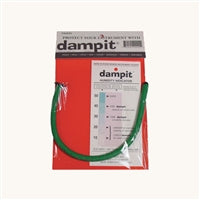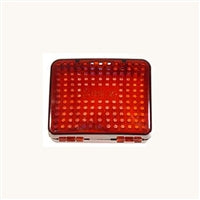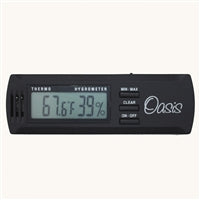
The Basics
A violin is a collection of wooden parts, held together with glue. In humid conditions, wood absorbs moisture from the surrounding air. Wood expands as it absorbs moisture. In dry conditions, wood releases moisture into the surrounding air. Wood contracts as it releases moisture. Violins are most comfortable in the same humidity and temperature conditions as the musicians who play them - i.e. 40% - 60% humidity, 60°F - 80°F. Extended exposure to very humid, or especially very dry conditions can cause serious damage to your instrument.
Problems for Violins in High Humidity (>60%)
- Tuning pegs may swell and become hard to work.
- Strings may be difficult to keep in tune.
- Bow hair will absorb moisture and become slack. Player may not be able to tighten hair sufficiently to play.
- Swelling of wood may cause soundpost to drop.
- Extended exposure to very high humidity may allow mold to grow inside the instrument.
- When combined with high temperatures, extended exposure to high humidity may cause seams to open or other structural problems.
Problems for Violins in Low Humidity (<40%)

- Tuning pegs may slip and become difficult to keep tight.
- Strings may be difficult to keep in tune.
- Extended exposure to dry conditions will put pressure on the soundpost, as the wood contracts and the violin shrinks. A tight soundpost can cause the belly of the violin to crack. (Soundpost cracks are an extremely common, and expensive, repair.) Seams may also open, and other structural problems may occur.
- Bow hair may become overly-tight. If not corrected (i.e. if the bow is left tightened in the case, in increasingly dry conditions, or if a bow is exposed to dry conditions while in shipment), the hair could become so tight that it damages the bow.
Solutions

Standard Cylinder-Style Case Humidifier
Our favorite case humidifier is a small plastic cylinder that easily installs in a small clip, mounted in the case. Many wooden cases come with a clip already installed. We've never had problems with leaking, so long as the humidifier is placed into a clip. (We do not recommend using this without an appropriate clip installed.) And, under average conditions, it requires filling only once every three to six days. (Note: it may need filling more often at first, as the case itself absorbs the humidity and becomes less dry.) The humidifier can be ordered with the appropriate mounting hardware; but, be aware that the screws are designed for wooden cases and can be difficult to mount in composite or foam.

Dampit Violin Humidifier
For players who are not able to use the case humidifier, above, we recommend the Dampit. This type of humidifier inserts into the violin itself, thorough the f-hole, providing moisture right where it is needed. It is extremely effective, though it must be filled more frequently than other humidifiers.

Box-Style Case Humidifier
An alternative to the cynlinder-style humidifier, the Stretto Colors Humidifier can be attached to the inside of almost any case with a small piece of velcro tape (included). Again, as with the cylinder-style humidifier, we do not recommend placing this humidifier inside the case without attaching it securely with the provided velcro tape. Available in multiple colors, and in the Original Stretto style.
The Advantage of Wooden Cases
As with the wood of a violin, the wood of a case will soak up moisture from the air, or release excess moisture if the air inside the case is dry. Consequently, wooden cases have a great advantage over composite or foam, since they act as their own humidifiers - or, at the least, as a buffer against changes in humidity. A humidifier placed inside a wooden case will be much more effective, since the humidifier will gradually add moisture to the wood of the case, and that, in turn, will add moisture to the air inside the case, as needed.
For example . . . Let's say that the humidity level in your home is 35%. By using a case humidifier, you keep the humidity inside your case at about 50%. You travel to a dry location for a performance. The moment you open your case, the air is replaced by the dry air at your performance location. With a composite or foam case, you must now rely completely on your case humidifier to maintain the moisture level of the air inside your case. With a wooden case, however, the moisture in the wood will raise the humidity of the new, dry air back up to near 50%, almost as soon as you close the lid. Your case humidifier would take longer to accomplish the same task. And, with a wooden case, this will happen even if your humidifier is empty!
Measuring Humidity
A hygrometer is a device used to measure the moisture content of the air. Many cases come with an analog hygrometer mounted in the lid. If your case does not have one, you can purchase an analog or digital hygrometer and mount it yourself with double-sided tape, or keep a digital hygrometer in an interior pocket. Keep in mind, when checking your hygrometer, that the reading may change after the case is opened. By checking it immediately, you can get an accurate reading of how humid the air was inside the case. But, several minutes later, if the case is left open, the reading will reflect the level of the air in the room, which may be considerably different.

Analog Dial Hygrometers
Analog hygrometers are attractive, but can be temperamental, and are not particularly accurate (plus or minus approx. 5%, if calibrated correctly). Moreover, it is often necessary to calibrate analog hygrometers in new cases, as they are frequently mis-calibrated (or not set at all) at the factory. This involves removing the hygrometer from the case (which can be tricky in and of itself) and requires a reference, such as a digital hygrometer, to which the analog hygrometer can be set. Furthermore, the wire coil inside analog hygrometers often sticks, resulting in jerky needle motion. If the needle in your hygrometer is not moving or showing a clearly inaccurate reading, it simply needs to be calibrated.
If you are considering the purchase of a case with an analog hygrometer, or if you have recently purchased such a case, we recommend purchasing a digital hygrometer as a supplemental tool. It will give you more accurate results and can be used to calibrate the analog hygrometer. Note: Analog hygrometers do not function well in the cold, and cases often get very cold while in shipment. So, if you have recently received a case with a poorly functioning hygrometer, please allow it a day or so to warm up (with the case lid open) before calibrating.

Digital Hygrometers
Digital hygrometers are much more reliable and precise, and react more quickly to humidity changes. We recommend digital hygrometers to most customers. But, they do require regular battery changes, approximately once per year.
